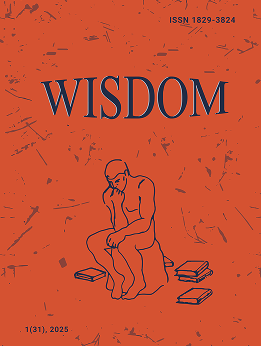Speech Aggression in Corporate Communication: The Gender Aspect in the Philosophy of Culture
DOI:
https://doi.org/10.24234/wisdom.v3i2.837Keywords:
philosophy of culture, speech aggression, philosophy of gender studies, women’s speech, men’s speech, gender factor, communicative linguistics, lexis, corporate communicationAbstract
The article sheds light on the means of verbal aggression expression as used in the speech of female and male native speakers of English in corporate communication within the gender framework in the philosophy of culture. The means of expression are analysed using the transcripts of talks and business meetings to single out their common use patterns. Research methodology is premised on the philosophical approach to culture, statistical data analysis, methods of continuous sampling, definitional analysis, textual analysis, component analysis and complex analysis of vocabulary units, as well as lexical and stylistic analysis. Upon examining the peculiarities of speech aggression, the authors address gender differences in speech act production. The study demonstrates the significance of the gender factor in implementing verbal behaviour strategies in cases of verbal aggression within corporate communication while also revealing some significant differences in male and female speech aggression in corporate communication (negative connotations in women’s and men’s speech).
Downloads
References
Alkhammash, R., & Al-Nofaie, H. (2020). Do Saudi academic women use more feminised speech to describe their professional titles? An evidence from corpus. Training, Language and Cul-ture, 4(3), 9-20. https://doi.org/10.22363/2521-442X-2020-4-3-9-20
Beger, R. (2018). Other areas of corporate communication. In Present-day corporate communication (pp. 507-636). Singapore: Springer. https://doi.org/10.1007/978-981-13-0402-6_8
Bonacchi, S. (2020). Sprachliche Expressivität, Emotionen und verbale Aggression (Linguistic ex-pressiveness, emotions and verbal aggression, in German). Linguistische Treffen in Wroc?aw (Linguistic meetings in Wroc?aw, in German), 17(1), 39-53. https://doi.org/https://doi.org/10.23817/lingtreff.17-3
Bowen, S. A. (2019). Corporate communication. In D. W. Stacks, M. B. Salwen, & K. C. Eichhorn (Eds.), An integrated approach to communication theory and research (pp. 390-406). http://dx.doi.org/10.4324/9780203710753-34
Crane, T. (2021). The philosophy of mind. Cambridge University Press.
D’Iribarne, P., Chevrier, S., Henry, A., Segal, J. P., & Tréguer-Felten, G. (2020). Cross-cultural management revisited: A qualitative approach. Oxford University Press. http://dx.doi.org/10.1093/oso/9780198857471.001.0001
Goodman, ?., & Hirsch, P. (2020). Corporate communication: Transformation of strategy and practice. Peter Lang. http://dx.doi.org/10.3726/b15075
Innis, R. E. (2016). Between philosophy and cultural psychology: Pragmatist and semiotic reflections on the thresholds of sense. Culture and Psychology, 22(3), 331-361. https://doi.org/10.1177/1354067X16638847
Jaafar, N., & Lachiri, Z. (2020). Combining speech features for aggression detection using deep neu-ral networks. In Proceedings of the 5th International Conference on Advanced Technologies for Signal and Image Processing ATSIP (pp. 1-6). IEEE. http://dx.doi.org/10.1109/ATSIP49331.2020.9231791
Jomah, N. (2020). Impact of corporate communication on employee motivation. International Journal of Scientific and Research Publications, 10, 674-677. http://dx.doi.org/10.29322/ijsrp.10.06.2020.p10279
Kemling, J. (2020). Toward a cultural philosophy: Five forms of philosophy of culture. Eidos A Journal for Philosophy of Culture, 4, 19-35. https://doi.org/10.14394/eidos.jpc.2020.0038
Khlopotunov, Y. (2019). Mockery as a tactic of destructive verbal communication in American politi-cal discourse. Professional Discourse & Communication, 1(2), 60-70. https://doi.org/10.24833/2687-0126-2019-1-2-60-70
Komalova, L. R. (2016). Verbal implementation of aggression as a product of social and cognitive deprivation. Journal of Psycholinguistics, 3(30), 103-115.
Lakoff, R. (1975). Linguistic theory and the real world. Language Learning, 25(2), 309-338. https://doi.org/10.1111/J.1467-1770.1975.TB00249.X
Larionova, T. V. (2020). Mechanism of discursive space transformation in the situation of verbal con-flict. Philological Sciences: Issues of Theory and Practice, 3, 220-225. https://doi.org/10.30853/filnauki.2020.3.46
Lefter, I., & Jonker, C. (2017). Aggression recognition using overlapping speech. In Proceedings of the 7th International Conference on Affective Computing and Intelligent Interaction ACII (pp. 299-304). IEEE. http://dx.doi.org/10.1109/ACII.2017.8273616
Likhacheva, T. S., Zavorueva, L. A., & Gerasimova, A. V. (2017). Verbal aggression: Ways to pre-vent it and to overcome the consequences. Philological Sciences: Issues of Theory and Prac-tice, 3(69), 125-127.
Malyuga, E. N., & Orlova, S. N. (2017). Linguistic pragmatics of intercultural professional and business communication. Springer. https://doi.org/10.1007/978-3-319-68744-5
Malyuga, E., & Tomalin, B. (2014). English professional jargon in economic discourse. Journal of Language and Literature, 5(4), 172-180. https://doi.org/10.7813/jll.2014/5-4/38
Malyuga, E., Krouglov, A., & Tomalin, B. (2018). Linguo-cultural competence as a cornerstone of translators’ performance in the domain of intercultural business communication. XLinguae. A European Scientific Language Journal, 2, 566-582. http://dx.doi.org/10.18355/XL.2018.11.02.46
Malyuga, E., Maksimova, D., & Ivanova, M. (2019). Cognitive and discursive features of speech eti-quette in corporate communication. International Journal of English Linguistics, 9(3), 310-318. http://dx.doi.org/10.5539/IJEL.V9N3P310
Matherne, S. (2021). Philosophy of culture as the philosophy of symbolic forms. In S. Matherne (Ed.), Cassirer (pp. 115-150). https://doi.org/10.4324/9781351048859-5
McGee, P. (2019). Cross-cultural pragmatic failure. Training, Language and Culture, 3(1), 73-84. http://dx.doi.org/10.29366/2019tlc.3.1.5
Orlova, S., Radyuk A., Oreshko V., & Ivanova, M. (2019). Stereotypes of speech behavior in Eng-lish corporate communication. In Proceedings of the 6th SWS International Scientific Confer-ence on Arts and Humanities (pp. 803-810). SGEM. http://dx.doi.org/10.5593/SWS.ISCAH.2019.1/S14.102
Oviedo, J. L. (2019). The role of corporate communication in intelligent organizations. Cuadernos de Administración (Universidad del Valle), 35(65), 105-117. http://dx.doi.org/10.25100/cdea.v35i65.7251
Potapchuk, V. ?. (2016). Corporate communication model in the 21st century. Communicology, 4(5), 152-172.
Rugen, B. D. (2019). Verbal aggressiveness and hate speech: New considerations for study abroad students. Language Teaching, 43, 15-34. http://dx.doi.org/10.37546/jalttlt43.3-3
Schmidt, C., & Rennhak, C. (2020). PR und die corporate communications. In C. Schmidt & C. Rennhak (Eds.), Public relations klipp & klar (pp. 1-31). Springer. https://doi.org/10.1007/978-3-658-27250-0_1
Shahul, B. (2020). Practical definition of corporate communication. Journal of Management, 35(65), 118-123.
Vlasova, O. P., & Makieshyna, Y. V. (2018). Transformation of the gender dichotomy of spirit and body in postmodern philosophy and culture. Anthropological Measurements of Philosophi-cal Research, 14, 107-118. https://doi.org/10.15802/ampr.v0i14.150751
Downloads
Published
How to Cite
Issue
Section
Categories
License
Copyright (c) 2022 scientific journal WISDOM

This work is licensed under a Creative Commons Attribution-NoDerivatives 4.0 International License.
Creative Commons Attribution-Non-Commercial (CC BY-NC). CC BY-NC allows users to copy and distribute the article, provided this is not done for commercial purposes. The users may adapt – remix, transform, and build upon the material giving appropriate credit, and providing a link to the license. The full details of the license are available at https://creativecommons.org/licenses/by-nc/4.0/.















